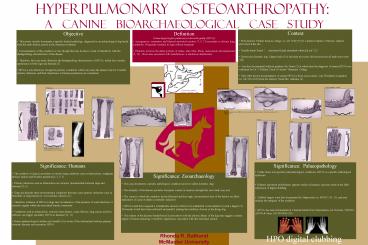Rhonda R. Bathurst - PowerPoint PPT Presentation
1 / 1
Title:
Rhonda R. Bathurst
Description:
Bilateral periosteal proliferation appears similar in humans, and may result in ... AD 500-1000) from the Hickory Bend Site, Alabama (4) Significance: Zooarchaeology ... – PowerPoint PPT presentation
Number of Views:69
Avg rating:3.0/5.0
Title: Rhonda R. Bathurst
1
Hyperpulmonary Osteoarthropathy A Canine
Bioarchaeological Case Study
- Context
- Proto-historic Neutral Iroquois village, ca. AD
154090 (2). Limited evidence of historic
artifacts uncovered at the site. - Bundle burial found articulated and
enmeshed within a pot (2) - Terrier-size domestic dog. Mature male (14),
less than two years old (most but not all teeth
were worn 15) - Case first documented (without graphics) by
Burns (2) at which time the diagnosis of canine
HPOA was confirmed by Dr. T. Hullard, Dean of
Ontario Veterinary College - Only other known documentation of canine HPOA
is from a pre-contact, Late Woodland occupation
(ca. AD 500-1000) from the Hickory Bend Site,
Alabama (4)
- Objective
- This poster visually documents a specific
skeletal pathology, diagnosed in an
archaeological dog burial from the early historic
period in the American northeast - Documentation of this condition is rare, though
this may be due to a lack of familiarity with the
distinguishing characteristics of the disease - Therefore, this case study illustrates the
distinguishing characteristics of HPOA, which has
a similar appearance in both dogs and humans (3) - HPOA is non-infectious, though the primary
conditions which can cause the disease may be.
Possible primary infections and their importance
to human populations are considered
- Definition
- Canine hypertrophic pulmonary osteoarthropathy
(HPOA) - A progressive, symmetric and bilateral
periosteal reaction (7, 9, 13) secondary to
chronic lung conditions. Frequently terminal in
dogs without treatment - Primarily involves the distal portions of
radius, ulna, tibia, fibula, metacarpals and
metatarsals (7, 12) - those sites associated with
membranous or tendonous attachments
Cleveland
Skull, dorsal view
Right mandible, medial
Phalanges
Skull, lateral view
Cleveland Site (AhHb-7). Northeast of Brantford,
Ontario
Tibia partial fused fibula
Left mandible, lateral
Calcaneus metatarsals
Scapula
Vertebrae, thoracic and lumbar
left
Marked changes due to HPOA are not usually noted
on the skull, vertebral column, ribs or sternum
(7).
III
Radius
II
Ulna
Forelimb x-ray (17)
left
right
Right calcaneus tarsus
Left metacarpals
right, caudal
left, cranial
Humerus
Femur
V
IV
Note comparative lack of periosteal reaction on
tarsus
left
II
V
III
IV
left
right
right
- Significance Palaeopathology
- Unlike many non-specific paleopathological
conditions, HPOA is a specific pathological
syndrome - Bilateral periosteal proliferation appears
similar in humans, and may result in the flesh
expression of digital clubbing - Clubbed fingers were first documented by
Hippocrates ca. 450 BC (10, 11), and may indicate
the antiquity of the condition - HPOA has been documented in 2 human burials
from Mesoamerica (in Ticoman, 2000 BC-AD100
Jaina, AD 300-900) (10)
- Significance Humans
- The condition in dogs is secondary to chronic
lung conditions such as tuberculosis, malignant
thoracic tumors and broncho-pneumonia (1, 5, 7) - Primary infections such as tuberculosis are
zoonotic (transmissible between dogs and humans)
(5, 6) - Dogs and humans share environmental conditions
that may cause primary infections such as
bronchitis or lung tumors (ie. wood smoke,
tobacco) (1) - Therefore, evidence of HPOA in dogs may be
indicative of the presence of such infectious or
causative agents within the associated human
community - Conditions such as tuberculosis, cyanotic heart
disease, cystic fibrosis, lung cancer and liver
cirrhosis can trigger secondary HPOA in humans
(10, 11) - Future epidemiological studies may benefit to
be aware of the relationship between primary
zoonotic diseases and secondary HPOA
right, cranial
right, cranial
left, caudal
- Significance Zooarchaeology
- This case documents a specific pathological
condition known to affect domestic dogs - The antiquity of the disease pre-dates European
contact in America (though this case study may
not) - The extent to which the condition had
proliferated and the rough, un-remodeled state of
the lesions are likely indications of cause of
death (a mortality indicator) - HPOA would have required a considerable amount
of time to be established on the skeleton to such
a degree (7). Movement would have been awkward
and painful, making the condition obvious in the
living dog - The context of the discrete bundle-burial in
association with the chronic illness of the dog
may suggest a certain degree of human nurturing
or symbolic significance associated with this
individual animal
left, caudal
Rhonda R. Bathurst McMaster University
HPO digital clubbing University of Bristol,
Faculty of Medicine, 2001































